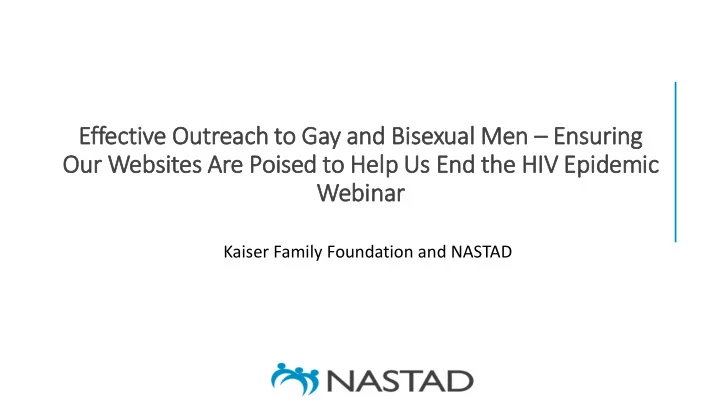

Effective Outreach to Gay and Bis isexual Men – Ensuring Our Websit ites Are Poised to Help lp Us End the HIV Epid idemic ic Webin inar Kaiser Family Foundation and NASTAD
Housekeeping ▪ Please mute your computer microphone or telephone during presentations ▪ Feel free to use the chat feature to ask questions; we’ll address these during the Q&A periods ▪ If you would like to ask your question, please click the raise hand button. We will open up the chat feature during the Q&A periods ▪ A recording of the webinar and slides will be made available ▪ There will be videos used during this webinar. We will note when this happens so as to adjust your sound ▪ For more information, contact Andrew Zapfel (azapfel@nastad.org) 2
Agenda ▪ Introductions ▪ NASTAD Work ▪ Greater Than AIDS ▪ Virginia Department of Health 3
NASTAD Case Studies – Strengthening Health Literacy for Gay, Bisexual and other Men Who Have Sex With Men 4
“Truth is defined by the top results of the Google search.” -Yuval Noah Harari 21 Lessons for the 21 st Century
Health Literacy ▪ Effective HIV and STD responses require sound communication strategies. ▪ Overall goal to strengthen health literacy of population. ▪ In 2013, 59% of adult Americans looked online for healthcare information. ▪ LGBT populations, including youth, are more likely to search online for sexual health information. Yet, where are they going? Is it a trusted source?
Methodology
General Review of Health Department Websites ▪ Research conducted in July and August of 2019. ▪ Question: Do health departments provide relevant health information (HIV, STDs, or holistic) for GBM/LGBT populations? ▪ Conducted a review of health department websites: o Is there information available? o Is it accessible? o Is it up to date?
Case Study Development ▪ From the survey of websites, four health departments were selected for interviews to understand: o Process for developing platform • Including bureaucratic challenges and opportunities for integration amongst programs o Engagement of community o Monitoring, Evaluation, and Learning
Findings
Who Has LGBT Health Information? DOES THE PUBLIC FACING WEBSITE INCLUDE LGBT HEALTH INFORMATION? Yes No 35% 65%
What Do The Websites Say? What LGBT Health Information Is Accessible On The Website? 10 9 8 7 6 5 4 3 2 1 0 LGBT Health HIV/STDs MSM Youth Only Other MSM and Only Transgender
Undetectable = Untransmittable NASTAD U=U Map November 2019
Case Studies
Rhode Island App – Right Time ▪ Developed in 2018 to discreetly disseminate clinically vetted STD information. ▪ Facilitate anonymous communication between sex partners. ▪ Access health information and prevention and treatment services in culturally competent way. ▪ Has been downloaded approximately 3,500 times, used in 25 languages, and downloaded in 52 countries.
Highlighted Findings ▪ Co Communit ity Engagement: Health departments found value in sharing drafts of the website pages to HIV Planning Groups and community members. ▪ Co Contin inuous Updates: Health departments should ensure someone is responsible for the general monitoring and updates of website information. ▪ Requir ires Ch Champio ions: : To get health departments to sign on to U=U as well as promote new policies, you need champions. ▪ Lin Link to Addit itio ional l Reso sources: When it is not possible for health departments to provide specific information, consider linking to existing reputable online resources.
Next Steps
Next Steps ▪ Next Steps o NASTAD is working with national partners, health departments and community based organizations to strengthen their health information available online for GBM and broader LGBT populations. ▪ Call to Action o As we work to end the HIV epidemic, we should think critically about what tools and resources we have let “lag” and make sure they are updated. o Engage partners and community in development and review of websites.
Additional Resources o NASTAD Brief: Strengthening Health Literacy for GBM: Case Studies of Health Department Websites o CDC National Action Plan to Improve Health Literacy o CDC National HIV Prevention Network o CDC Gay and Bisexual Men’s Health Website o Building Healthy Online Communities Coalition o Kaiser Family Foundation’s Greater Than AIDS o Prevention Access Campaign U=U Campaign
Gay Men’s Health Equity Work Group ▪ NASTAD recognizes the disproportionate impact HIV and other STDs have on gay, bisexual and other men who have sex with men (GBM). ▪ The work group provides a platform for conversations on best practices as well as new resources and tools to support an effective response. ▪ If interested in joining, contact Andrew Zapfel (azapfel@nastad.org).
Thank You! Andrew Zapfel azapfel@nastad.org Manager, Health Equity NASTAD
Greater Than AIDS and Virginia Department of Health 22
Recommend
More recommend